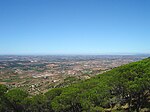Peral, Portugal
Lisbon geography stubsPages with Portuguese IPAParishes of Cadaval
Peral (Portuguese pronunciation: [pɨˈɾal]) is a freguesia (civil parish) of Cadaval Municipality, Portugal. The population in 2011 was 905, in an area of 16.46 km². One of its villages is Barreiras.
Excerpt from the Wikipedia article Peral, Portugal (License: CC BY-SA 3.0, Authors).Peral, Portugal
Cadaval
Geographical coordinates (GPS) Address Nearby Places Show on map
Geographical coordinates (GPS)
| Latitude | Longitude |
|---|---|
| N 39.262 ° | E -9.075 ° |
Address
2550-450 Cadaval
Portugal
Open on Google Maps




